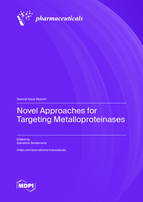Novel Approaches for Targeting Metalloproteinases
A special issue of Pharmaceuticals (ISSN 1424-8247).
Deadline for manuscript submissions: closed (30 June 2022) | Viewed by 34062
Special Issue Editor
Interests: ADAMTS; proteoglycans; monoclonal antibodies; exosite inhibitors; enzyme kinetics; proteomics; proteoglycanomics; phage display
Special Issue Information
Dear Colleagues,
Metalloproteinases play key roles in physiological processes such as embryonic development, wound healing, angiogenesis, and blood coagulation, as well as pathologies like arthritis, cardiovascular disease, and cancer. In the therapeutic context, either decreasing or increasing the activity of a particular metalloproteinase may be ideal. This can be achieved, for example, through the action of molecules able to bind to substrate-binding sites (exosites) present on the ancillary domains of these enzymes or interfere with their transcriptional or post-translational regulation.
Potential contributors are invited to submit papers concerning modulators of metalloproteinase activity in any pharmaceutical or related context. Particularly welcome are studies involving exosite inhibitors/enhancers, substrate mimetics, natural products, and glycoconjugates, as well as peptides, aptamers, monoclonal antibodies, and engineered proteins. Novel approaches for the therapeutic delivery of these reagents are also appreciated.
I look forward to reading your submission.
Dr. Salvatore Santamaria
Guest Editor
Manuscript Submission Information
Manuscripts should be submitted online at www.mdpi.com by registering and logging in to this website. Once you are registered, click here to go to the submission form. Manuscripts can be submitted until the deadline. All submissions that pass pre-check are peer-reviewed. Accepted papers will be published continuously in the journal (as soon as accepted) and will be listed together on the special issue website. Research articles, review articles as well as short communications are invited. For planned papers, a title and short abstract (about 100 words) can be sent to the Editorial Office for announcement on this website.
Submitted manuscripts should not have been published previously, nor be under consideration for publication elsewhere (except conference proceedings papers). All manuscripts are thoroughly refereed through a single-blind peer-review process. A guide for authors and other relevant information for submission of manuscripts is available on the Instructions for Authors page. Pharmaceuticals is an international peer-reviewed open access monthly journal published by MDPI.
Please visit the Instructions for Authors page before submitting a manuscript. The Article Processing Charge (APC) for publication in this open access journal is 2900 CHF (Swiss Francs). Submitted papers should be well formatted and use good English. Authors may use MDPI's English editing service prior to publication or during author revisions.
Keywords
- metalloproteinases
- exosites
- inhibitors
- enhancers







